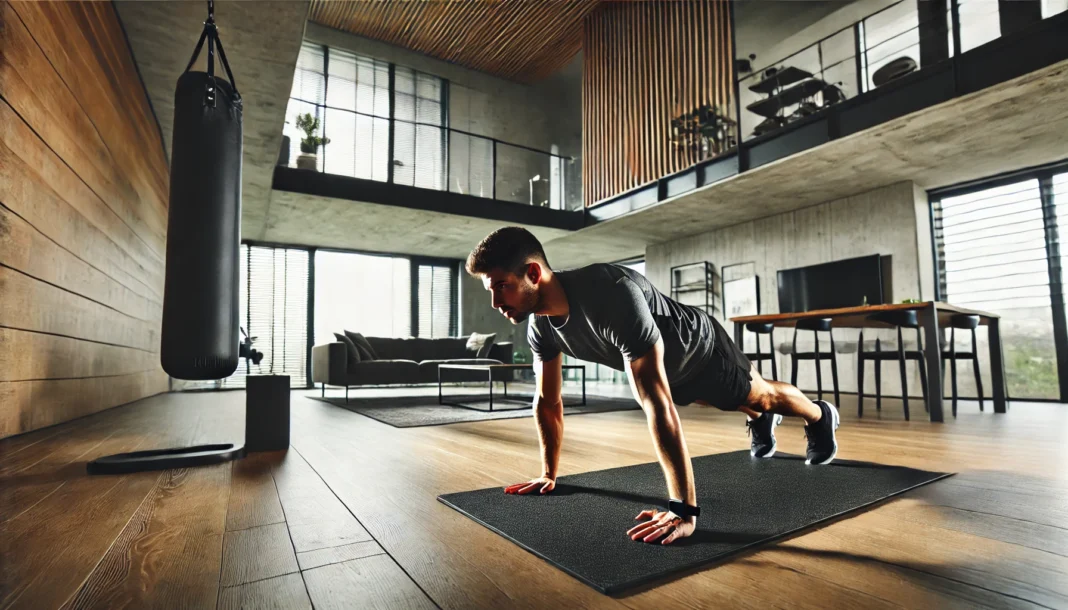Introduction: The Power of Bodyweight Training
Bodyweight exercises are among the most accessible and effective ways to build strength, endurance, and overall fitness without requiring specialized equipment. With the right structure, a 20-minute bodyweight workout can target multiple muscle groups, improve cardiovascular health, and enhance mobility. For beginners, bodyweight exercises provide a safe and adaptable foundation that allows gradual progression in strength and endurance. A bodyweight exercise program for beginners eliminates the intimidation factor often associated with traditional gym settings, making fitness more approachable. In this guide, we will explore how to construct an efficient beginner bodyweight routine that delivers maximum results within a short time frame.
You may also like: The Ultimate Bodyweight Workout Routine for Full-Body Strength and Performance
The Science Behind Bodyweight Training
Strength training is often associated with lifting weights, but research shows that bodyweight exercises can be equally effective when properly executed. A beginner bodyweight workout no equipment approach leverages gravity and body mass to create resistance, leading to significant muscular engagement. Studies indicate that beginners’ bodyweight workout routines enhance neuromuscular coordination, improve balance, and reduce the risk of injury. Moreover, the dynamic nature of bodyweight movements increases heart rate, making it an excellent form of cardiovascular exercise. By structuring a 20-minute bodyweight workout, individuals can optimize both muscular and aerobic conditioning.
Structuring an Effective 20-Minute Bodyweight Workout
A 20 min bodyweight workout should be balanced to ensure full-body activation and prevent muscle imbalances. A well-rounded routine typically consists of compound movements that engage multiple joints and muscles simultaneously. These exercises include squats, lunges, push-ups, and core work, all of which are integral to a bodyweight exercise program for beginners. The key to an efficient beginner bodyweight routine is to incorporate variations that challenge different muscle groups while maintaining proper form. Additionally, the inclusion of high-intensity intervals can elevate heart rate, enhancing calorie burn and metabolic benefits.
Lower Body Movements for Strength and Endurance
Lower body exercises play a crucial role in a beginners’ bodyweight workout routine, as they build foundational strength for everyday movements. Squats, for example, are one of the most effective exercises for developing quadriceps, hamstrings, and glutes. A beginner bodyweight workout no equipment approach can be intensified by incorporating squat jumps, Bulgarian split squats, or isometric holds. Lunges further activate stabilizing muscles and enhance mobility, contributing to overall lower-body endurance. By incorporating dynamic lower-body movements into a 20-minute bodyweight workout, individuals can improve strength while boosting cardiovascular efficiency.

Upper Body Workouts Without Weights
While traditional strength training often involves dumbbells or barbells, a bodyweight exercise program for beginners can effectively target upper-body muscles without equipment. Push-ups remain one of the best exercises for developing chest, shoulder, and triceps strength. Modifications such as incline or decline push-ups help adjust difficulty levels in a beginner bodyweight routine. Additionally, triceps dips using a stable surface further isolate arm muscles, enhancing upper-body endurance. By structuring upper-body movements within a 20 min bodyweight workout, individuals can experience strength gains comparable to resistance training.
Core Training: Stability and Functional Strength
Core training is an essential component of any beginner bodyweight workout no equipment approach. A strong core enhances posture, reduces injury risk, and improves overall athletic performance. Exercises such as planks, leg raises, and bicycle crunches provide comprehensive core engagement, making them ideal for a beginners’ bodyweight workout routine. Functional core movements, such as mountain climbers and hollow holds, further challenge stability and endurance. Incorporating core-focused exercises within a 20-minute bodyweight workout ensures well-rounded muscular development.
Cardio and High-Intensity Intervals for Fat Burn
A well-designed 20 min bodyweight workout should include high-intensity movements to maximize calorie burn and cardiovascular health. Burpees, jumping jacks, and high knees elevate heart rate and contribute to improved metabolic conditioning. These explosive exercises, when incorporated into a beginner bodyweight routine, enhance overall endurance and agility. For individuals seeking a more intense challenge, circuit training formats allow seamless transitions between strength and cardio movements. A bodyweight exercise program for beginners that integrates high-intensity intervals delivers significant fitness improvements in a short amount of time.
Recovery and Mobility: Essential Components of Progression
Recovery is often overlooked in fitness routines, yet it is crucial for sustainable progress. A beginner bodyweight workout no equipment approach should incorporate cooldown exercises such as static stretching and yoga-inspired movements. These activities enhance flexibility and promote blood circulation, aiding muscle recovery post-workout. Additionally, foam rolling or self-myofascial release techniques help alleviate muscle tension, preventing stiffness and soreness. By prioritizing mobility within a beginners’ bodyweight workout routine, individuals can maintain long-term fitness success and prevent injuries.
How to Track Progress in a Bodyweight Training Program
One of the challenges of bodyweight training is tracking progression without external resistance. A 20-minute bodyweight workout can be adapted to increase intensity through higher repetitions, time-under-tension techniques, or advanced variations. Logging workout performance, such as repetitions completed or time held in static positions, provides measurable progress markers. A bodyweight exercise program for beginners should also incorporate periodic fitness assessments, such as timed plank holds or push-up endurance tests. By consistently monitoring improvements, individuals can maintain motivation and ensure continued physical development.
Common Mistakes to Avoid in a Beginner Bodyweight Routine
Beginners often make mistakes that hinder progress in their training. One common error is neglecting proper form, leading to inefficient movement patterns and potential injuries. A beginner bodyweight workout no equipment routine should emphasize controlled movements over high-speed repetitions. Another mistake is lack of variety, as repeating the same exercises without progression results in stagnation. Additionally, failing to incorporate adequate recovery time can lead to burnout and muscle fatigue. Structuring a beginners’ bodyweight workout routine with proper programming ensures consistent gains without unnecessary setbacks.
The Psychological Benefits of Bodyweight Training
Beyond physical improvements, a 20 min bodyweight workout provides mental health benefits that enhance overall well-being. The accessibility and simplicity of bodyweight exercises reduce stress, making it easier for individuals to stay consistent with fitness habits. Studies have shown that structured bodyweight workouts improve mood, reduce symptoms of anxiety, and enhance cognitive function. A bodyweight exercise program for beginners also fosters a sense of achievement, as progress can be observed through strength gains and endurance improvements. Incorporating mindfulness techniques, such as controlled breathing during movements, further enhances the mental benefits of a beginner bodyweight routine.

Frequently Asked Questions: 20-Minute Bodyweight Workout
1. What makes a 20-minute bodyweight workout effective for beginners? A 20-minute bodyweight workout is highly effective for beginners because it focuses on fundamental movements that enhance strength, endurance, and mobility. By utilizing compound exercises such as squats, lunges, and push-ups, this type of workout activates multiple muscle groups simultaneously, leading to greater efficiency. Additionally, structured rest intervals between sets allow for sustained performance throughout the session. A well-designed 20 min body weight workout incorporates progressive overload, encouraging gradual increases in difficulty to maintain consistent progress. Lastly, this format supports consistency, as shorter workouts are easier to adhere to while still delivering meaningful fitness improvements.
2. How can a beginner bodyweight routine help build strength without equipment? A beginner bodyweight routine develops strength through controlled movements and the strategic use of body weight as resistance. Exercises like planks, push-ups, and squats require core engagement, enhancing stability and functional strength. Additionally, progressive variations, such as incline push-ups leading to standard push-ups, gradually increase difficulty, allowing muscles to adapt over time. A beginner bodyweight workout no equipment approach also improves neuromuscular coordination, making everyday activities easier. Incorporating tempo changes, such as slow eccentric movements, further intensifies workouts without adding external resistance.
3. What are the key components of a bodyweight exercise program for beginners? A well-balanced bodyweight exercise program for beginners includes foundational exercises targeting the lower body, upper body, and core. Lower-body movements like squats and lunges develop leg strength and stability, while push-ups and dips strengthen the upper body. Core exercises such as planks and leg raises improve posture and overall endurance. A successful beginners bodyweight workout routine also incorporates dynamic movements, such as high knees and jumping jacks, to elevate heart rate and boost cardiovascular fitness. Ensuring proper form and incorporating gradual progressions help beginners build confidence while minimizing injury risk.
4. How often should I do a 20-minute bodyweight workout for optimal results? For optimal results, beginners should aim to complete a 20 min body weight workout at least three to four times per week. This frequency allows for adequate recovery while maintaining consistency, a crucial factor in developing strength and endurance. As fitness levels improve, individuals may increase frequency or incorporate more challenging variations. A well-structured bodyweight exercise program for beginners includes active rest days with activities like stretching or light walking to promote muscle recovery. Listening to the body and adjusting intensity based on progress ensures long-term sustainability.
5. How can I modify a beginner bodyweight routine to prevent plateaus? To prevent plateaus, individuals can modify a beginner bodyweight routine by increasing time under tension, incorporating advanced variations, or adjusting workout intensity. For instance, slowing down the descent in squats or push-ups increases muscle engagement, making exercises more challenging. Transitioning from knee push-ups to full push-ups or incorporating jump squats adds an element of progression. Another effective strategy is modifying the workout structure by implementing circuit training, where exercises are performed with minimal rest between sets. Rotating between different variations in a beginners bodyweight workout routine keeps the body adapting and prevents stagnation.
6. Can a 20-minute bodyweight workout improve cardiovascular fitness? Yes, a well-designed 20-minute bodyweight workout can significantly enhance cardiovascular fitness, particularly when incorporating high-intensity intervals. Exercises such as burpees, mountain climbers, and jump squats elevate heart rate, providing both strength and endurance benefits. A structured 20 min body weight workout that alternates between strength-based and cardio movements maximizes metabolic conditioning. Engaging in consistent workouts improves heart and lung efficiency, leading to better stamina over time. Integrating bursts of cardio within a bodyweight exercise program for beginners optimizes both muscular and aerobic endurance.
7. How can I ensure proper form in a beginner bodyweight workout no equipment routine? Maintaining proper form in a beginner bodyweight workout no equipment routine is essential to prevent injuries and maximize effectiveness. Beginners should focus on controlled movements, ensuring that joints are aligned and posture remains upright during exercises like squats and lunges. Engaging core muscles throughout the workout helps stabilize movements and prevents excessive strain on the lower back. Using mirrors, recording workouts, or seeking guidance from instructional videos can aid in identifying and correcting form errors. Practicing each movement slowly before increasing speed or intensity reinforces proper technique.
8. What are the benefits of a 20-minute bodyweight workout compared to longer sessions? A 20-minute bodyweight workout offers efficiency by targeting multiple muscle groups within a condensed timeframe, making it ideal for individuals with busy schedules. Shorter workouts encourage consistency, reducing the likelihood of skipping sessions due to time constraints. Research indicates that high-intensity, short-duration workouts can provide similar strength and cardiovascular benefits as longer sessions. Additionally, a well-structured 20 min body weight workout reduces the risk of overtraining while maintaining sufficient intensity for progress. Combining brief, frequent sessions with proper recovery fosters long-term adherence to a fitness routine.
9. What are common mistakes to avoid in a beginners bodyweight workout routine? Common mistakes in a beginners bodyweight workout routine include neglecting warm-ups, using improper form, and failing to progress workouts over time. Skipping warm-ups can lead to stiffness and increased injury risk, making dynamic stretching crucial before exercising. Improper form, such as rounding the back in push-ups or lunges, reduces effectiveness and may cause strain. Another frequent mistake is performing exercises too quickly without focusing on controlled movements. Lastly, not adjusting workout intensity or exercise variations can lead to stagnation, highlighting the importance of progression in a bodyweight exercise program for beginners.
10. Can a 20-minute bodyweight workout be effective for long-term fitness goals? Absolutely. A 20-minute bodyweight workout can be a sustainable component of long-term fitness when paired with progression and consistency. Over time, individuals can increase the challenge by incorporating new exercises, adjusting rep ranges, or adding variations. A beginner bodyweight workout no equipment routine can evolve into an advanced program by integrating plyometrics, isometric holds, or additional movement complexity. Additionally, combining bodyweight training with mobility work and proper nutrition supports overall fitness development. Whether aiming for strength, endurance, or general health improvements, a structured bodyweight routine can provide lasting benefits.

Conclusion: Embracing Bodyweight Training for Long-Term Fitness
A 20-minute bodyweight workout offers a time-efficient and effective way to build strength, endurance, and mobility without requiring expensive equipment. A bodyweight exercise program for beginners should be structured to incorporate full-body movements, high-intensity intervals, and progressive challenges. By maintaining consistency and tracking progress, individuals can experience significant fitness improvements within a short timeframe. Additionally, prioritizing recovery and proper technique ensures long-term success in a beginner bodyweight routine. Whether aiming for strength gains, fat loss, or improved cardiovascular health, a beginner bodyweight workout no equipment approach remains one of the most sustainable and accessible fitness methods available.
fitness at home, bodyweight strength training, beginner workout plan, no-equipment exercises, home fitness routine, functional training, strength without weights, high-intensity bodyweight exercises, mobility and flexibility, core training, endurance workouts, circuit training, full-body exercise plan, fitness progression, workout recovery, home cardio training, exercise for beginners, simple fitness routine, bodyweight HIIT, muscle endurance training.
Further Reading:
The Beginner Bodyweight Workout: 20-Minute Routine To Do At Home or Anywhere!
Beginner Bodyweight Workout – Full Body – No Equipment | 20 Minutes
Important Note: The content provided by HealthXWire is for informational purposes only and should not be construed as medical advice, diagnosis, or treatment. While we strive for accuracy, the information presented on this site may not reflect the most current research or medical guidelines. Always seek the advice of your physician or other qualified health provider with any questions you may have regarding a medical condition. HealthXWire does not endorse, recommend, or guarantee the efficacy of any products, services, or treatments mentioned on this site. Users should not disregard professional medical advice or delay seeking it because of something they have read on HealthXWire. HealthXWire is not liable for any damages, loss, or injury arising from reliance on the information provided herein.



